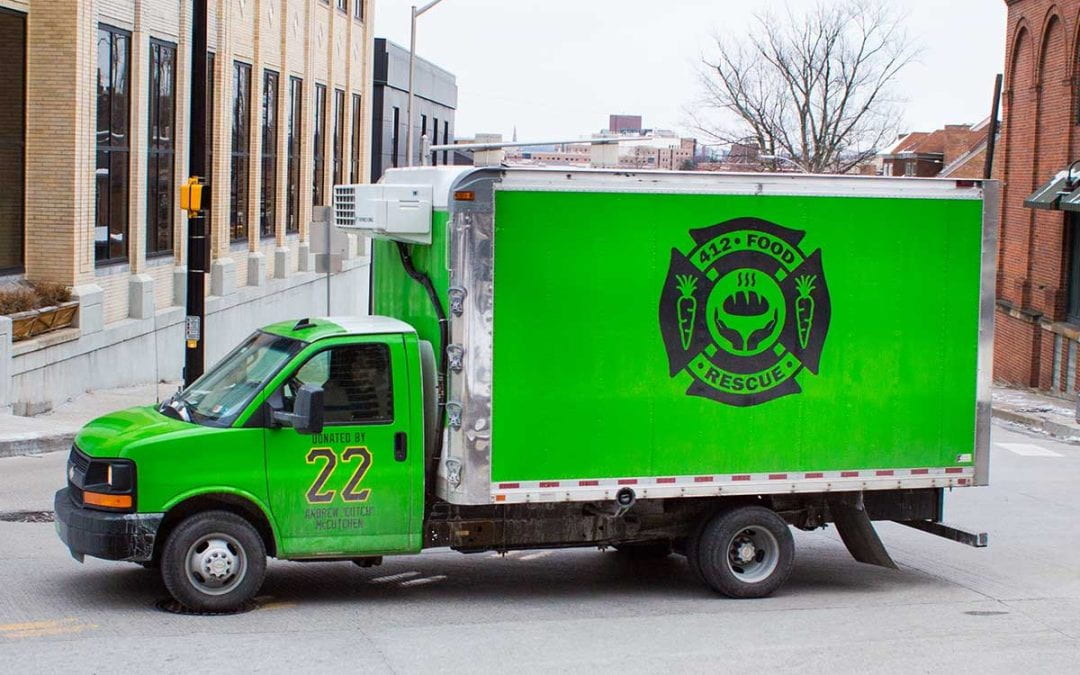On Tuesday, November 1st, Jen England joined us to discuss food waste, its impact on the environment, and how to divert this food to people who could use it. Jen is the Chief Operating Officer for 412 Food Rescue, an organization based out of Pittsburgh with a mission of recovering food waste and delivering it to those who may be facing food insecurity and/or low food access.
She began by discussing the overall environmental impact of food waste, detailing the large amount of carbon or methane emitted by food in landfills. 10% of greenhouse gas emissions come from food waste. Waste accumulates along the whole food distribution chain – from unsellable produce, to food at grocery stores not being sold, to someone not finishing their dinner.
Jen then described 412 Food Rescue’s method to recover wasted food. The organization has an app similar to Uber, called Food Rescue Hero, where they connect organizations with food to donate, recipient organizations, and volunteers who make the transfer. They work with various donors, such as big grocery stores like Trader Joes that have a large amount of food that will not be sold. They specifically work with food distributors that prioritize and cater to communities that suffer from food insecurity, but not all distributors are food-related organizations. For example, they work with the Housing Authority of the City of Pittsburgh to provide food to various senior living facilities. 412 also supported a program for school children, where children could pick up a meal and more at their neighborhood bus stops, places they felt comfortable and safe walking to, during the pandemic when online school meant no lunch programs.
Beyond their food rescue operation, they have other programs to contribute to food access and waste mitigation, such as one called “UglyCSA”. “UglyCSA” is like a normal, subscription-based CSA program, but the name comes from the fact that the produce is usually “seconds” – food not sold to larger stores because of appearance or lack of need. It is still completely safe and yummy. Another program, called the Good Food Project, utilizes extra donated food to make grocery bags and meals that are distributed frozen to people with limited time to cook or shop healthfully.
One important point that Jen highlighted was that they do not give people “waste”. Even though it is a donation and food that would not have otherwise been used, it is still perfectly safe and good – the food is not less than any other food. This contributes to food dignity and 412’s mission to make sure people feeling good about the food they are eating and where they got it. They are not giving people bad quality food, expired food, and they prioritize offering culturally relevant food to specific partners and ensuring people have choices in the food they receive.
She also discussed the expansion of programs like 412 Food Rescue: their app is currently used around the nation. In Pennsylvania, there are programs in Erie and Philadelphia in addition to Pittsburgh. Combined, these programs have saved 115 million pounds of food and mitigated 62.4 pounds of carbon dioxide since the program’s release. While it takes a bit to get started, the impact on communities and the environment is big, and a step in the direction of food access for everyone.
Resources to Learn More
- https://412foodrescue.org/: This is 412 Food Rescues official website. They prevent perfectly good food from entering the waste stream by redirecting it to those who are experiencing food insecurity.
- https://www.sciencedirect.com/science/article/abs/pii/S0264275115000931 : This paper critically analyzes a local food rescue CSO as a case study in order to understand the challenges associated with food waste governance in LA and the roles that CSOs play in food waste reduction. Through an analysis of interview and participant observation data in LA’s food system, this paper examines the ways that food waste is produced, regulated, and reused by institutions in LA, and provides a basis for analyzing food rescue options and operations around the country.
- https://www.ncbi.nlm.nih.gov/pmc/articles/PMC6571599/#:~:text=In%20the%20pilot%20year%20of%20the%20convention%20food%20rescue%20program,food%20insecure%20individuals%20were%20produced. : The purpose of this study was to document the amount of food diverted from landfill in the pilot year of a convention food rescue program and to determine the amount of greenhouse gas (GHG) emissions avoided by the diversion of such food. It provides helpful context into why food rescue and waste diversion are impactful for climate change mitigation.
- American Wasteland: How America Throws Away Nearly Half of Its Food (and What We Can Do About It)
This book, American Wasteland, sheds light on the history, culture, and mindset of waste while exploring the parallel eco-friendly and sustainable-food movements. As the era of unprecedented prosperity comes to an end, it’s time to reexamine our culture of excess. - The Waste Not, Want Not Cookbook: Save Food, Save Money, and Save the Planet
You’ll learn how to transform leftovers into delicious new dishes, how to store and preserve foods to make them last, how to shop smartly when buying in bulk, and interpret “best-before” dates. You’ll even learn how to cook once and create three different meals.

